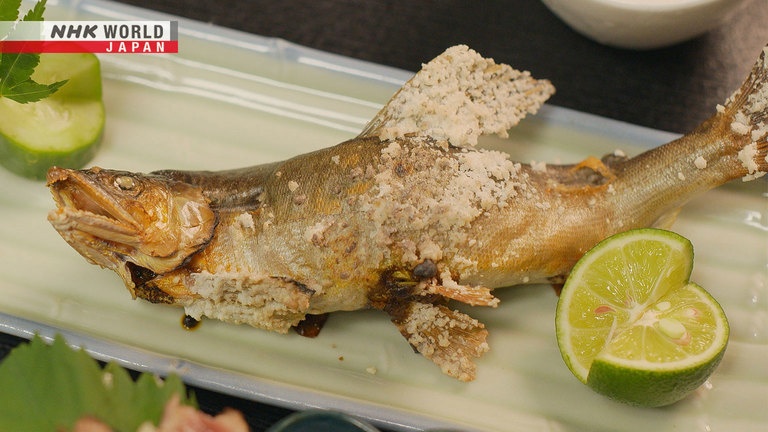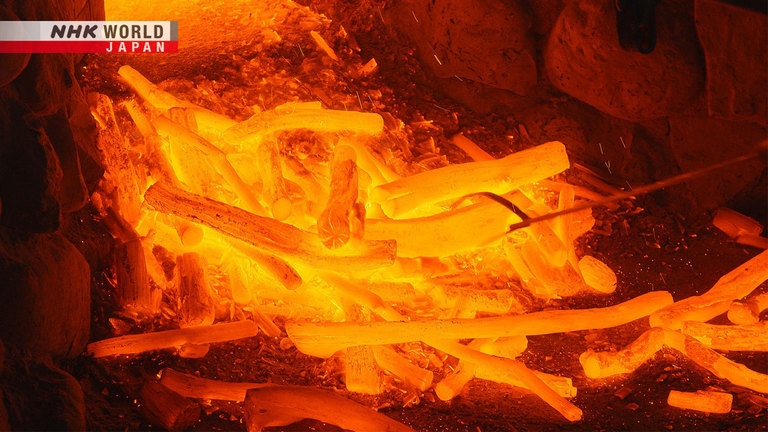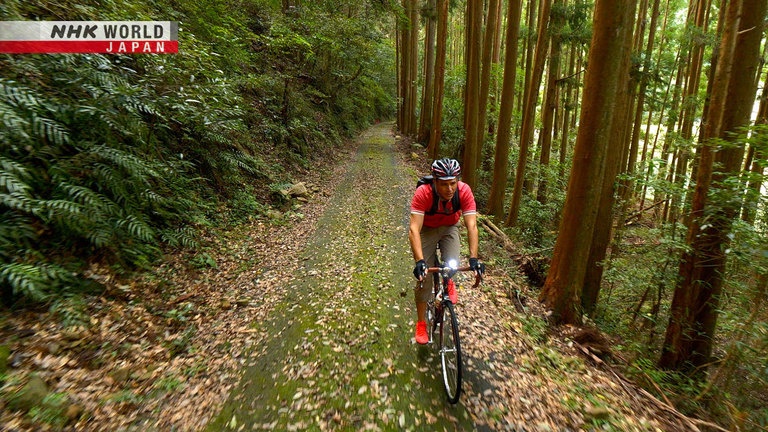Kochi - Land of Rivers
In a land of mountains, forests and fast-flowing rivers, we try our hand at catching sweetfish, climb up to an organic farm perched on a steep hillside, and go right inside a charcoal maker's kiln.




Transcript
The best way to discover little-known sights and make even familiar places feel brand new, is to go exploring by bicycle.
This time, we're in Kochi, known as the land of rivers.
In this part of Japan, you're never far from water.
People live close to nature in this fertile countryside.
The plants I grow feel like a part of me.
That's what keeps me farming.
For many, life here is an endless quest to make better use of Kochi's natural abundance.
From the forest to the sea, it's time to embark on a spirited three-day, midsummer ride through Kochi. Let's go!
Kochi City is the largest of the prefecture, with a population of 320,000.
A major attraction is the morning market, held four times a week in the shadow of the city's old castle.
Sunday is the busiest day, when stalls selling vegetables and seafood stretch for over a kilometer.
I've got all kinds of stuff here.
This is Bobby Judo, from Florida in the USA.
When he isn't cycling, Bobby works as a reporter and culinary researcher who digs into local foods and ingredients.
Good morning! What are you selling?
All kinds of handmade foods, like inakazushi.
- Inakazushi? What's that?
- Sushi, but using all sorts of vegetables.
- Is this it?
- Yes.
Very pretty. I see myoga ginger.
And that's konnyaku, right? Bamboo shoots too.
"Inakazushi," made from wild mountain ingredients, was traditionally eaten here at festivals and celebrations.
It's got that firm, crisp texture to the bamboo, and it's got that vinegary sweetness that you expect from sushi.
Now that Bobby's had something to eat, it's time to hit the road!
That's awesome.
I want to try to get some distance in this morning before it gets too hot.
We have this big, broad river over here on the left.
The Niyodo River takes a winding route through the mountains.
This is one of Kochi's three major rivers.
We've got a really nice view right here.
Some stronger currents down through there. Wow.
Starting to get a little bit of a light rain.
Not too bad. I hope it holds off.
We can see a couple of people fishing down here in the river.
This is on my must-do list while we're here.
Bobby has arranged to go fishing with this couple.
- Hello! Are you the Nishiwakis?
- Hi there!
Nishiwaki Yasushi and Aki make their living catching sweetfish.
This river produces the highest quality sweetfish, which they sell to top-class Kyoto restaurants.
- You can use this rod.
- Wow, that's long!
This is a short one. Only 7 meters.
The water in this tributary of the Niyodo River is among the purest in Japan.
Yasushi also likes this particular spot since it's easy for beginners to keep their footing.
He'll teach Bobby how to use live decoy fish.
This method takes advantage of the sweetfish's habit of defending its feeding area.
A decoy fish with hook attached is placed in the feeding area, and the attacking sweetfish is caught by the hook.
The main point is not to leave the decoy fish
on the line too long, as it gets weak and lifeless.
Too much tension on the line weakens the decoy fish, so the skill lies in guiding it gently towards the feeding area.
- Do you fish? Other kinds, I mean.
- Yes, but I've never got the knack.
Mostly I go home empty-handed.
But it's great to be out in nature.
Ah! I got something!
Yes! Get the net ready as you reel it in.
Here it comes!
Caught it!
I got one.
Decoy fish must swim vigorously to be effective, so they use the freshest.
Each time a new fish is caught, it's used to replace the decoy.
Yasushi once worked at a company in Kyoto.
There, he met Aki, who is from Kochi, and his life changed forever.
After I showed him some Kochi rivers,
he was hooked. All he wanted to do was fish.
- The water in these rivers is so clear.
- Sweetfish from pure water taste divine.
After that first experience of the Niyodo River and the taste of its sweetfish,
Yasushi gave up his job and moved to Kochi to spend the rest of his life fishing on this river.
He insists that the best-tasting sweetfish are caught using the decoy method.
This method lets us catch sweetfish in the best condition,
so they stay healthy in the tank.
They stay fresh right up till you eat them.
People we teach always say these are
the best they've ever tasted.
Our aim is to show people how to catch
sweetfish and see how good it tastes.
They all say the difference is incredible.
Bobby has brought the sweetfish he just caught to a nearby hotel, where he'll get them cooked.
He'll try them cooked with salt, which preserves their original flavor, and cooked in rice seasoned with soy sauce.
That's really, really good.
So fresh.
It's soft, it's light, it's flaky, it's perfectly seasoned.
It's unbelievably good.
Now for some sweetfish rice.
It's really, really good.
That's delicious.
Day two takes Bobby to another of Kochi's great rivers.
The 194-kilometer long Yoshino River is famous for its many rapids.
Bobby's come from the river to the mountains.
The slopes become steeper and steeper.
In the end, this hill is just a bit too much for our cyclist.
That was quite a climb.
I made it all the way up here.
And I think I see some people at work up in the field over here.
- Hello!
- Good morning!
Tending their crops are Wada Toyoki and Kazumi.
The Wada family has farmed these slopes for generations.
Their farm is located on a hill overlooking the village.
At this height, the Wada's crops thrive on the pure mountain spring water.
Toyoki has thought deeply about the best ways to farm in this unique environment.
The most important thing is soil preparation.
I cut wild grass on the ridge up there for mulch
to feed the good microorganisms in the soil.
For Toyoki, weeds are an important resource.
He uses them to improve drainage and aerate the soil, activating microorganisms that enhance the flavor of his vegetables.
Oh, this is so sweet! Crunchy and juicy!
Glad you like it.
You don't need to cook it at all,
it tastes great fresh.
Born to a family of rice farmers, Toyoki naturally began growing rice himself after high school.
But soon after, the government introduced policies to reduce rice production, so he started thinking about other kinds of farming.
In this fertile area so blessed by nature, he decided to focus on growing safe, high-quality vegetables.
Walking through the field like this,
I sometimes just stop and look around.
The leaves of all these different plants
seem to flutter in a special way.
Are they trying to talk to me?
It always moves me deeply.
But the more farmers rely on the power of nature, the more they're vulnerable to nature's unpredictability.
- They don't seem all that healthy?
- You're right.
We just had two typhoons.
Constant rain and no sunshine stunted their growth.
I've been growing tomatoes for 30 years and
I've never seen anything like this before.
Typhoons pass over Kochi every year, but this summer brought unusually heavy rainfall.
Toyoki's harvest was only 60 percent of the usual crop.
So what is it that makes you want to continue farming?
My plants have come to feel like a part of me.
Seeing and touching them everyday,
that's what keeps me farming.
They give me strength to keep going.
Bobby will try some homemade cuisine cooked up with Toyoki's signature veggies.
I'll start with the eggplant tempura.
The eggplant itself is so soft and juicy.
For fifty years Kazumi has been Toyoki's indispensable partner on their farm,
while at the same time running the house and raising four children.
- How is the food?
- Delicious. As usual.
Him saying that must make you happy.
He'll comment if it's too hot or sweet,
but when he likes it he says nothing.
Maybe I don't say much, but I know
I'd be at a complete loss without her.
It's the best feeling when guests tell us the food is delicious.
Hearing that makes all the work worthwhile.
I never want to stop doing this.
Bobby starts his final day on the Yasuda River.
A tunnel built into the side of the mountain here.
Kochi has a thriving forestry industry.
The timber used to be transported by rail out of these hills, and many tunnels remain to this day.
It's started to smell some smoke through here.
I think I even see some clouds wafting up over there.
Bobby has come into these forests specially to meet someone.
- Excuse me. Are you Morimoto san?
- Yes.
- I'm Bobby. I've come to watch you work.
- You're very welcome.
Morimoto Seichō is a charcoal maker.
He specializes in "binchōtan" - a type of very high grade charcoal that's long burning and gives a strong flame.
Morimoto is the leading producer of the kind called "Tosa Binchōtan."
It's almost done now.
Time to take it out.
Logs stay in the kiln for 20 days, with Morimoto constantly monitoring and controlling the heat.
Today is the final day, when the finished charcoal can be taken out.
Over here there's some I took out earlier.
It's quite heavy.
It really is quite a weight.
The wood shrinks to half its original size.
It gets so dense, it becomes hard like metal.
What a lovely high tone. You'd never think charcoal
would make a sound like this.
Morimoto is continually researching better ways to make charcoal,
experimenting with different methods of drying the logs and varying the kiln temperatures.
He's especially focused on improving the design of his kilns, which he builds himself by hand.
Building the kiln is the hard part.
It's the basis of everything. If the kiln isn't right,
you won't get good charcoal from it.
Morimoto takes Bobby inside a kiln.
This is intense.
- It's very high.
- About 3 meters.
Kilns must be strong enough to withstand temperatures of 1,000 degrees, and be completely airtight.
Morimoto has built more than 20 kilns, using a variety of shapes and materials.
The more I learned about the technical aspects,
the more interesting it became for me.
The quality changes completely depending on the
way you char the wood to remove moisture.
Charcoal making really is a very deep process.
Morimoto is now planting oak trees to pass on charcoal making to future generations.
The trees normally grow on steep hills, but he is planting them in more accessible areas.
I won't be here to fell the trees I plant,
but I still work to keep the mountain covered in trees.
That way, in 30 or 40 years, someone will be able to
cut them down to make charcoal.
We need many mountains like this to continue
providing work for people of the region.
I hope more young people will want to become
charcoal makers.
One man's passion - a flame that will burn long after he's gone.
Bobby heads for his goal: Cape Muroto.
We're on the Muroto Skyline.
Cyclists love this road, with its panoramic views over the Pacific.
We made it.
Pounded by waves, Cape Muroto is a long headland jutting sharply out into the Pacific.
Look at this incredible coastline.
You can really feel the raw power of the ocean.
This was a great trip.
It was nice to get to meet so many people making their living together with nature in these places that are so beautiful.
And there are really difficult things about living that kind of life as well.
You can't always make nature do what you want it to do.
But these people have found a lifestyle and a way of living that makes them even more a part of nature.
Kochi has been absolutely wonderful.
I definitely want to come back.
Nature in the wild - sometimes kind and beautiful, sometimes unsparingly harsh -
demands the courage to take on challenges and to believe in the future.